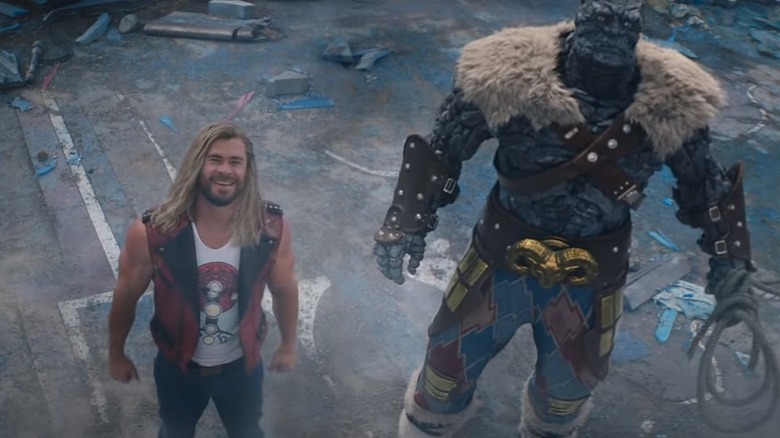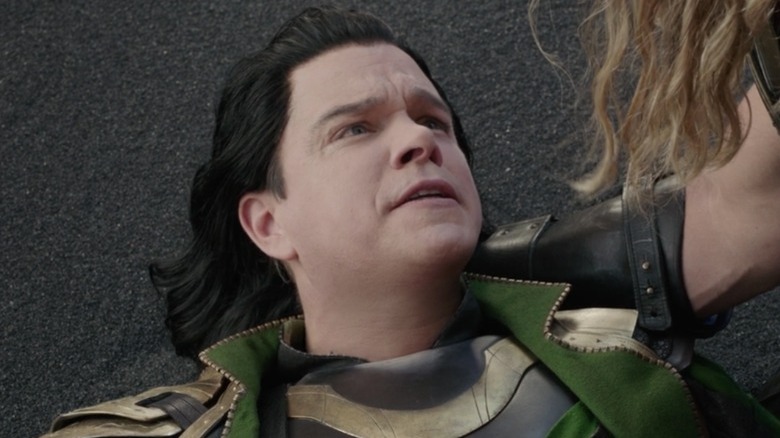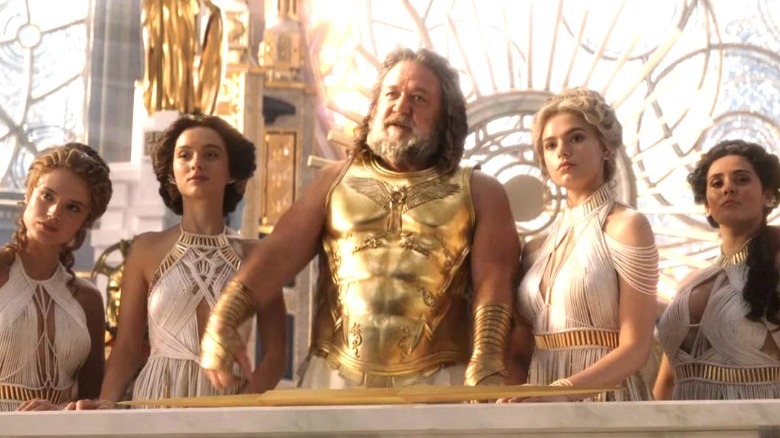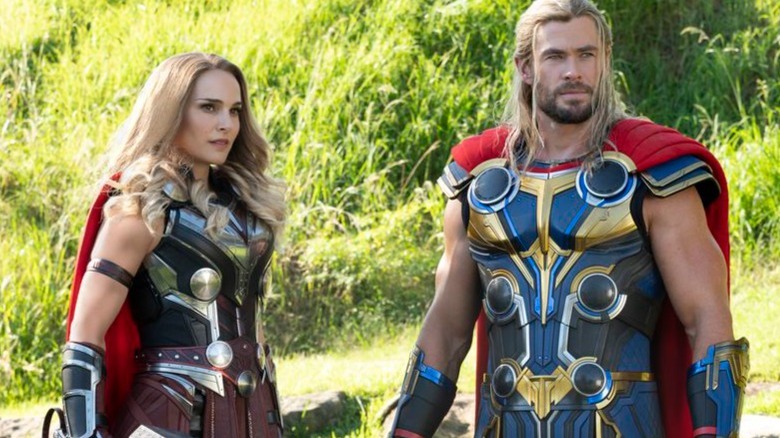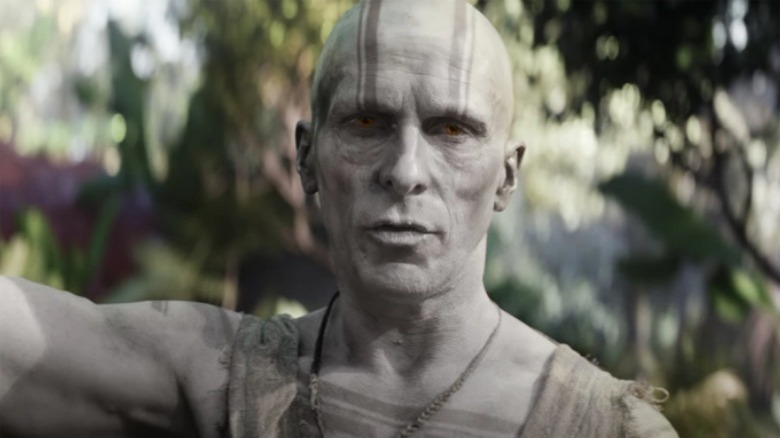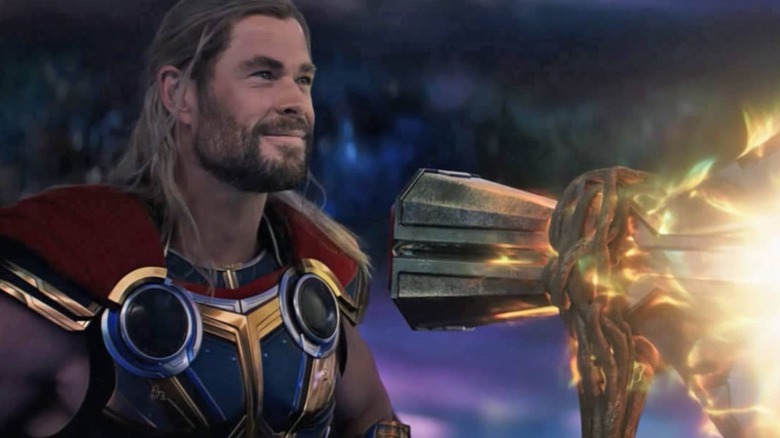5 Thor: Love And Thunder Moments That Are Pure, Undistilled Taika Waititi
If you've seen any other films by writer-director Taika Waititi, you may notice pretty quickly that "Thor: Love and Thunder" is chock full of Taika-isms. The filmmaker makes movies that are entertaining and energetic, childlike in their spirit and subject matter, and endlessly imaginative. He co-wrote the latest Thor film with "Someone Great" writer-director Jennifer Kaytin Robinson, and together the pair made a film that's about as zany and fun-loving as a Marvel flick can get.
Of course, "Thor: Love and Thunder" is part of the Marvel machinery, which doesn't always let its filmmakers' sensibilities shine through as much as smaller or more independent projects might. So which parts of "Thor: Love and Thunder" actually feel like classic Waititi? The whole film is laced with his humor, but more than that, it also touches upon themes that he's explored throughout his filmmaking career, beginning all the way back in 2007 with a little film called "Eagle vs. Shark." Here are five moments from the new movie that are in line with the writer-director's established storytelling sensibilities.
Warning: There are SPOILERS below for "Thor: Love and Thunder."
Ragnarok: The Play
"Thor: Love and Thunder" includes plenty of original humor, but Waititi and Robinson clearly couldn't resist bringing back one of its predecessor's most well-received jokes. In "Thor: Ragnarok," Matt Damon appears in an overwrought Asgardian play, taking on the role of Loki opposite Luke Hemsworth's version of Thor. The new movie brings the bit back, with a surprise addition: Melissa McCarthy pops up as the wrathful goddess Hela. It's a purposely goofy, amateurish production featuring a costume change gone awry and some lackluster practical effects.
The play isn't just a callback to "Thor: Ragnarok," but a classic Waititi motif. The filmmaker is clearly really into the idea of creative performance, and the sillier or more homemade the playacting looks, the better. "Boy" is full of scenes of the titular character (James Rolleston) and his dad (Waititi) blending reality with fantasy as the former imagines the latter as a Michael Jackson-type dancer and heroic adventurer. In "Jojo Rabbit," Scarlett Johansson's Rosie smeared soot on her face to pretend to be Jojo's (Roman Griffin Davis) father in a more serious take on the dress-up motif. Even as his films deal with heavier subject matter, they always find time to put on a show.
Meeting in Omnipotence City
In a seemingly random side quest that turns out to have a potentially lasting impact on the MCU, Thor (Chris Hemsworth), Jane (Natalie Portman), and Valkyrie (Tessa Thompson) head to Omnipotence City, where they sneak into a massive meeting of the world's dieties in order to ask Zeus (Russell Crowe) for a favor. It turns out, Zeus is kind of a jerk, which is pretty in line with how Waititi's movies have always viewed authority figures. From "Boy" to "Jojo Rabbit" and beyond, the filmmaker has frequently touched upon the idea of hero figures being total letdowns. In this case, Zeus minimizes the threat Gorr (Christian Bale) poses and is more worried about looking cool — and scheduling his annual orgy — than he is about actually being a leader.
It's not just Zeus' hubris that makes this scene feel like classic Waititi, though: the filmmaker also pays homage to his homeland, Aotearoa, in the sequence by including a Māori god among the pantheon. As one of the world's most celebrated Indigenous filmmakers, Waititi has long-since centered or referenced Māori tradition and New Zealand culture in his works. Even "Thor: Ragnarok" included a smattering of meaningful Easter eggs, like a spaceship decked out in Aboriginal flag colors.
Feeling sh***y for love
Early on in "Thor: Love and Thunder," Starlord (Chris Pratt) gives Thor a piece of advice: find someone who makes you feel sh***y. It seems counterintuitive, but he's basically telling the god of Thunder not to close himself off to love out of fear over how bad heartbreak might feel. Later, when Thor and Jane finally talk through their feelings, the god repeats the phrase as a declaration, telling Jane he wants to feel sh***y with her. After he explains himself, he admits he does feel that way, and she admits she feels scared. They kiss anyway.
This moment, and Jane and Thor's romance as a whole, bolster a sweet but vulnerability-averse take on love and relationships that dates all the way back to Waititi's first film, "Eagle vs. Shark." The awkward romance movie stars Jemaine Clement and Loren Horsley as a pair of geeky lovers who have trouble connecting thanks to Clement's character's idiosyncrasies and family trauma. 2014's "What We Do in the Shadows," which Clement co-wrote and co-directed, also features a lead who's worried about getting his heart broken: Viago (Waitit), a vampire who's been daydreaming about the same woman for nearly a century. All of Waititi's stories seem to conclude that love alone won't fix someone's problems, but that it sure could make us all happier along the way.
The Asgardian kids fight back
Waititi's most obvious signature on "Thor: Love and Thunder" is also one of the movie's main plot points: the capture and recovery of the Asgardian kids. The filmmaker has a knack for telling stories about resourceful young people, and often casts kids in heroic roles or as leaders who know more about how to save themselves than the adults in their lives do. Take Ricky Baker (Julian Dennison), the rebellious orphan who goes on the run in "Hunt For The Wilderpeople," for example.
The filmmaker's long, successful track record telling believable and entertaining stories about kids means it wasn't exactly a surprise when the Asgardian children captured by Gorr became the film's true heroes — but it was still an epic moment nonetheless. The Norse god gave the captured little ones, led by Heimdal's son Axl (Kieron L. Dyer), the temporary power of lightning that they used to help defeat Gorr's army of shadow monsters. To add an even more imaginative touch, apparently the "Thor: Love and Thunder" team created the creature designs based on his and his cast and crew members' own kids' artwork.
Love & Thunder
The climax of "Thor: Love and Thunder" features a heartfelt twist that turns parenthood into the stuff of legends. It turns out the Love and Thunder in the film's title wasn't actually Thor and Jane Foster, but the nickname for Thor and his adoptive daughter, the resurrected child of Gorr. By turning Thor into a story about finding meaning through being a superpowered, super-fun dad to a tiny tyrant, Waititi and Robinson subvert fans' expectations about what can and should matter in big comic book blockbusters like these. A victory for this movie doesn't mean saving the world so much as keeping it together for the people you love.
If you've seen a Waititi film before, it should go without saying that this aligns very well with his entire cinematic ethos. Nearly all of his movies have touched upon the heartaches and struggles of parenthood, often from the perspective of a child coming to terms with their own parents' shortcomings. "All my films are about family," Waititi told /Film's Hoai-Tran Bui in an interview ahead of the film's release. This time, though, the filmmaker offers a hopeful inversion of his previously bittersweet theme: we see parenthood from Thor's perspective, as he enthusiastically embraces the ridiculousness that comes with raising a kid as strong-willed, powerful, and hilarious as Love. They're saving the world together, and making each others' worlds better, too.
